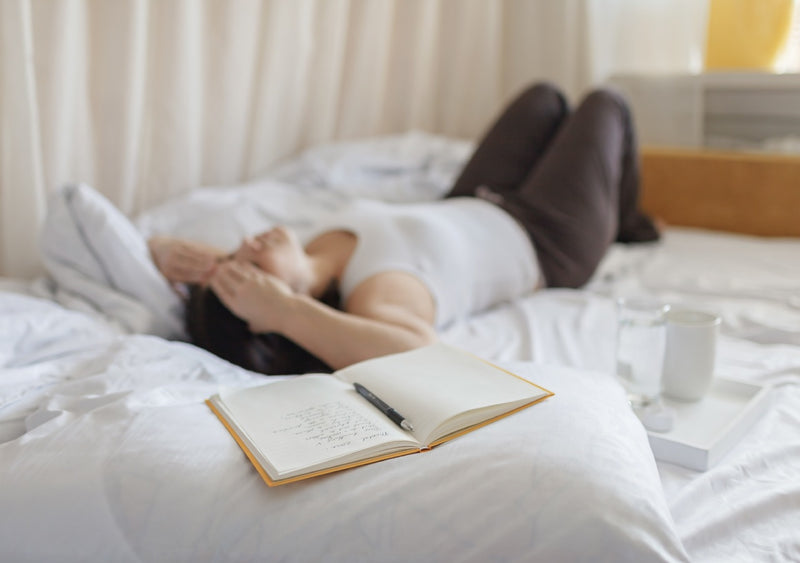
Guide On Unlocking The Zzz Using A Sleep Diary
Posted by Gavin Tan on
Tired of tossing and turning all night long, yearning for the sweet embrace of a restful slumber? We feel you. In a fast-paced world filled with responsibilities and distractions, achieving a good night's sleep can seem like an elusive dream. However, fret not – all you need to help you in your quest for a blissful sleep is the humble sleep diary!
Although wearable smart devices may offer convenience and advanced features, the traditional method of using a sleep journal allows for a more intimate and comprehensive understanding of your sleep patterns. It provides a tangible and personal connection to your sleep journey – much like pouring your heart out in your pocket-sized diary – enabling you to track and analyse crucial details contributing to your overall sleep quality.
Sleep diaries aren’t only for chronic sleeping problems. If you wake up on some mornings ready to take on the world, and other mornings barely able to tackle your coffee machine, monitoring your sleep can lead you to make small changes to your daily sleep habits that will help you consistently get your best snooze.
Here’s how you can harness the benefits of a sleep diary to fall asleep like a baby!
Understanding the sleep diary
Before we dive into the practical aspects of a sleep journal, let's first digest what a sleep diary is. A sleep diary is a simple yet effective tool that helps you monitor your sleep patterns, identify any poor sleeping habits, and start getting on track to rest better.
Psychologists and sleep therapists usually recommend these traditional sleep trackers to diagnose or rule out sleep disorders. It involves recording various aspects of your sleep, such as bedtime, wake-up time, sleep duration, and subjective sleep quality. In your sleep diary, you can include factors that may influence your sleep, such as caffeine intake, exercise, stress levels, and bedtime routines.
By consistently keeping track of your sleep schedule and habits, you can gain valuable insights into your sleep patterns and identify areas for improvement.
How to use a sleep diary effectively
Now that we know what a sleep diary is, let's explore how you can unlock its full potential for a healthier and blissful slumber.
Record relevant information
In your sleep diary, include details such as:
- The time you went to bed and woke up
- How long and well you slept
- When were you awake during the night
- What disturbed your sleep
- How much caffeine or alcohol you consumed and when you consumed it
- What or when you ate and drank
- What emotion or stress have you experienced
- What drugs or medications you took
- Amount of screentime you had before bed
- Amount of physical activity you did before sleeping
Be observant
Make use of the limitless pages of a sleep journal and note any patterns or trends that emerge from your sleep tracking. Look for correlations between your sleep quality and other variables, such as daily activities, diet, or emotional well-being, and jot this down.
These observations will help you identify potential triggers or factors that influence your sleep so that you can take the necessary steps to address them appropriately.
Prioritise sleep hygiene
Your sleep diary can be used to help you monitor and improve your sleep hygiene. You can also write down your daily sleep hygiene as you note your daily sleep habits. This includes keeping track of what you did before bed and how your bedroom condition was that day.
Always ensure your sleep environment is conducive to restful sleep by keeping your bedroom cool, dark, and quiet. Additionally, establish a relaxing bedtime routine that promotes winding down, such as reading a book or taking a warm bath.
Set realistic goals
Based on the insights gained from your sleep diary, set achievable goals for improving your sleep habits. Many people fail to sleep better after using a sleep journal because they set unrealistic expectations.
One of the secrets to a good night’s sleep is to start a routine you can follow. For example, if you consistently have trouble falling asleep, you may aim to establish a calming pre-sleep routine or limit screen time before bed.
Consistency is key
As with any habit-tracking or goal-setting process, consistency is key. Without a steady routine of tracking and noting your sleep patterns, you can never identify the exact problem or diagnose yourself accurately.
So, commit to recording your sleep data consistently by setting a regular bedtime and wake-up time. This will help establish a sleep routine that aligns with your body's natural sleep-wake cycle.
Seek professional guidance
Consider consulting a healthcare professional or sleep therapist if your sleep issues persist or worsen despite your efforts. Share your sleep diary with them to aid in their evaluation and explore potential underlying causes or conditions that may be affecting your sleep.
Incorporating a sleep diary into your daily routine may require some discipline and effort, but the rewards are well worth it. However, remember that a sleep journal is not a magic solution, but rather a tool that empowers you to understand and take control of your sleep. Use it as a compass to navigate your way towards better sleep habits and a more fulfilling life.
We hope this guide will help you utilise your sleep diary properly so that you can reap the benefits of a good and healthy slumber! At MiGOALS, we design our organisational tools to specifically benefit your well-being and aid your personal development. From high-quality planners and journals to desk accessories and more, view MiGOALS’ awesome collection of stationeries to turn your life around!